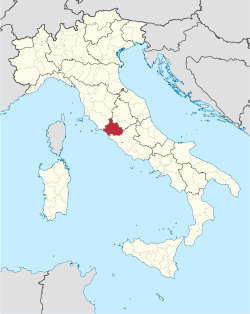Province of Viterbo | |
|---|---|
 Palazzo dei Papi (Palazzo Papale), in Viterbo | |
 Map with the province of Viterbo, in red, in Italy | |
| Country | |
| Region | Lazio |
| Capital | Viterbo |
| Comuni | 60 |
| Government | |
| • President | Alessandro Romoli (FI) |
| Area | |
• Total | 3,615.24 km2 (1,395.85 sq mi) |
| Population (30 April 2017) [2] | |
• Total | 318,163 |
| • Density | 88/km2 (230/sq mi) |
| GDP | |
| • Total | €6.559 billion (2015) |
| • Per capita | €20,425 (2015) |
| Time zone | UTC+1 (CET) |
| • Summer (DST) | UTC+2 (CEST) |
| Postal code | 01100, 010xx |
| Telephone prefix | 0761, 0763, 0766, 06 |
| Vehicle registration | VT |
| ISTAT | 056 |
| Website | Official website |
The province of Viterbo (Italian : provincia di Viterbo) is a province in the Lazio region of Italy. Its capital is the city of Viterbo. [4]







